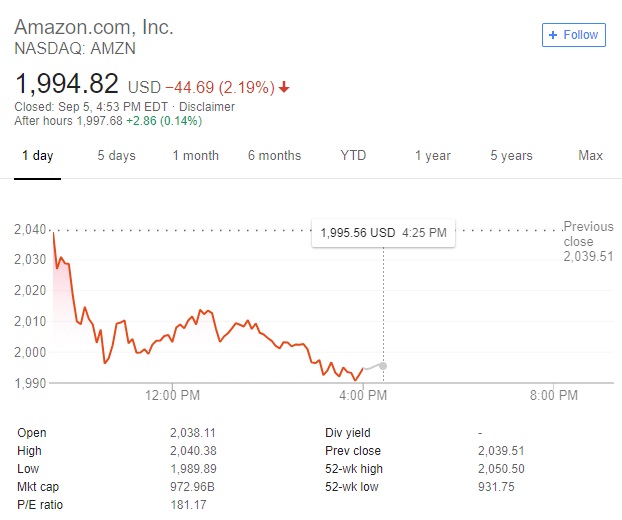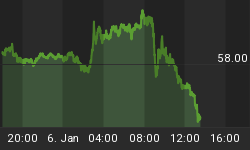Stocks in e-commerce giant Amazon hit $2,050.27 Tuesday, catapulting it in to the Trillion-Dollar Club, along with Apple, the first ever U.S. company to hit $1 trillion.
But while Tuesday gained Amazon entry into club, Wednesday has seen it drop back down, losing 2.19 percent as of 4:53PM EST, to $1,994.82 a share and a market cap of $980.05 billion.

(Click to enlarge)
U.S. stocks fell again today, led by tech stocks that saw their biggest one-day drop in months, dragging the Nasdaq down with them. Amazon, Microsoft and Apple are all seeing declines today, and the Dow is shooting for its fourth consecutive day of decline.
Analysts generally agree that there isn’t a clear catalyst for the tech slide, with MarketWatch citing Evercore ISI analyst Douglas DePietro as attributing to it “class sector rotation”.
“These groups have been outperforming, and this could be an example of investors taking profits, particularly since September is a historically turbulent month and a lot of big banks and brokerage houses have been encouraging their clients to lighten up on their tech exposure,” he said. Related: Cost Of Living In The UK Is Out Of Control
It was inevitable that the e-commerce giant would join the (lonely) ranks of Apple in the Trillion-Dollar-Club, and some believe it will outrank Apple soon enough.
After all, we all just witnessed Amazon’s Q2 earnings, which more than doubled the Wall Street consensus. AMZN reported earnings of $5.07 per share (GAAP) during Q2, far outdoing expectations of $2.48. That huge profit beat helped Amazon overcome its revenue posting of $52.9 billion (+39.4 percent Y/Y), which was $470 million below the consensus.
For Q2, the numbers were all about a surge in profitability in its ecommerce segment, whereas it’s always primarily relied on its AWS could service for the big bucks (up to 60 percent of operating profits, at times). That’s not to say that the cloud business is being overshadowed—not at all. It still account for 54.7 percent of total operating profit, coming in at $1.64 billion. For overall revenue, the cloud brought in $6.1 billion, or 11.5 percent of the total.
It’s also helping that Amazon’s has upped its Prime subscription pricing by $20 as of May 11, which means we should see some even better e-commerce numbers in Q3, assuming they’ve been signing on as many more new members as they are hinting.
But this is probably just the beginning for Amazon, even though it’s a rather broad spectrum beginning.
There are a couple of trillion-dollar segments that Amazon hasn’t tapped into yet, but if it stays true to its tradition, it probably will. It’s expansion from bookseller has indeed been terrifyingly diverse, and has included everything from food delivery and cashier-less mini-marts to shoes, consumer stables, clothing and upscale retailers.
Related: Citigroup Is Betting Big On This Sci-Fi Technology
Its most recent push into the $8-trillion healthcare sector is a case in point. Amazon Echo is being tested as a home healthcare tool, and the company has also invested in “Grail”—a cancer detection startup. The most publicized foray, though, is its partnership with JPMorgan and Warren Buffett’s Berkshire Hathaway to form an independent healthcare company for employees. It may even get into more sophisticated distribution of medical supplies.
It’s not likely to stop here, either. What it if got into gas stations and travel whole-heartedly, for instance? They’re both trillion-dollar businesses.
So, Apple may have been the first to make it into the club on July 2, with its share price hitting $207.05, but we can more clearly see the end of Apple’s reach, while for Amazon, the show’s just getting started.
By Tom Kool for Safehaven.com
More Top Reads From Safehaven.com

















